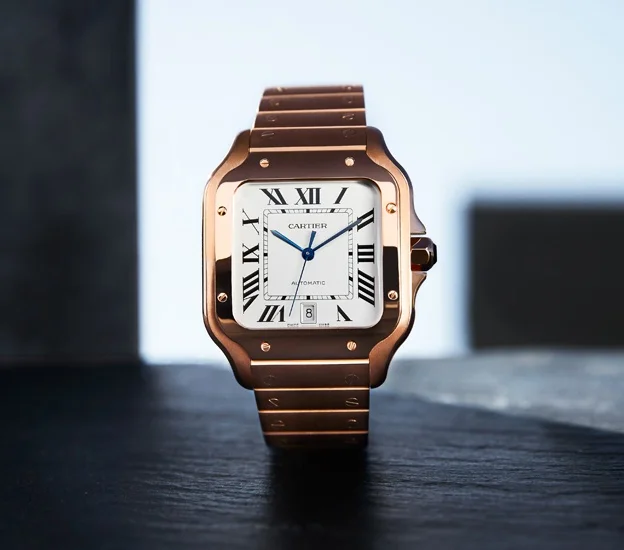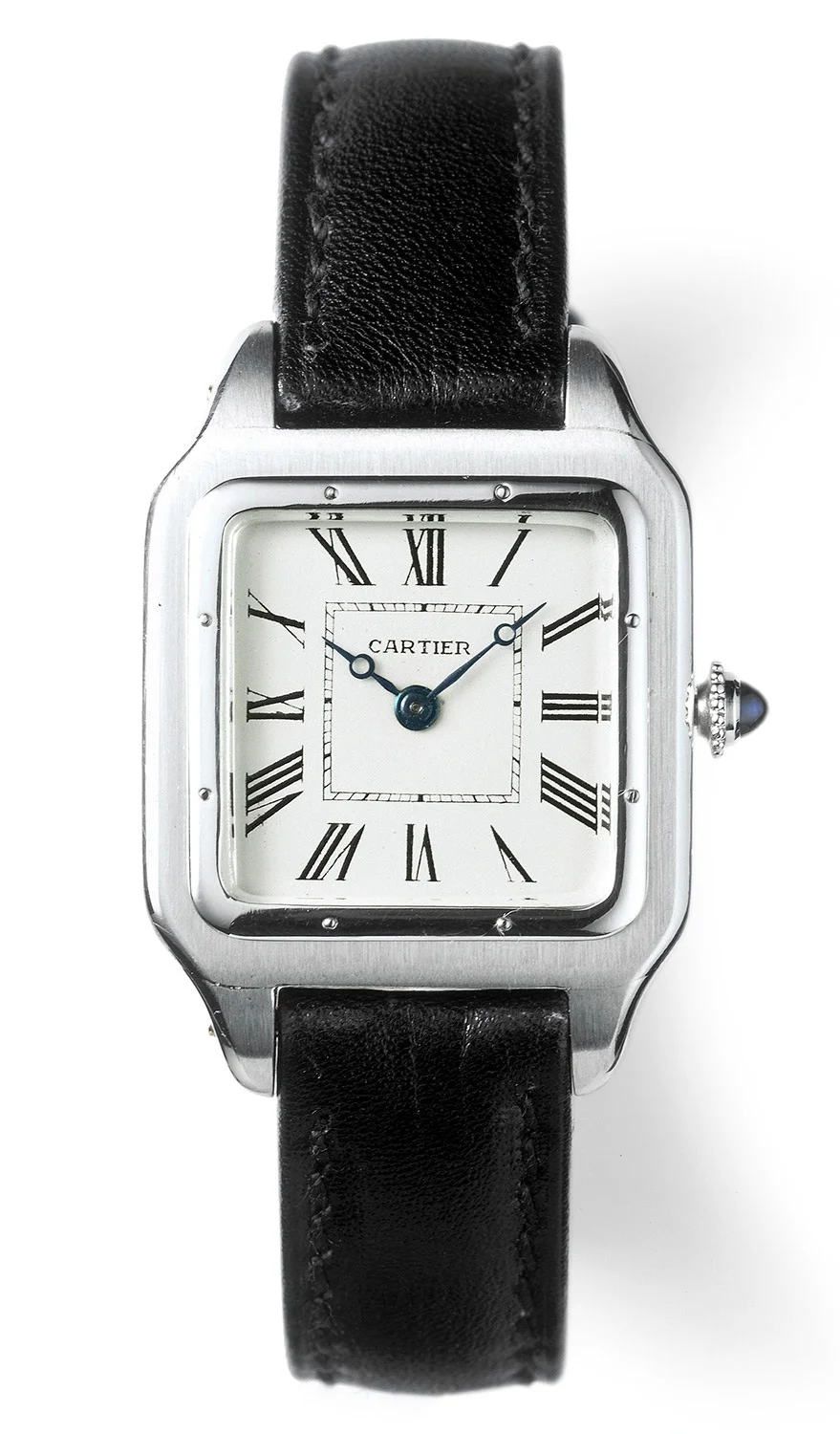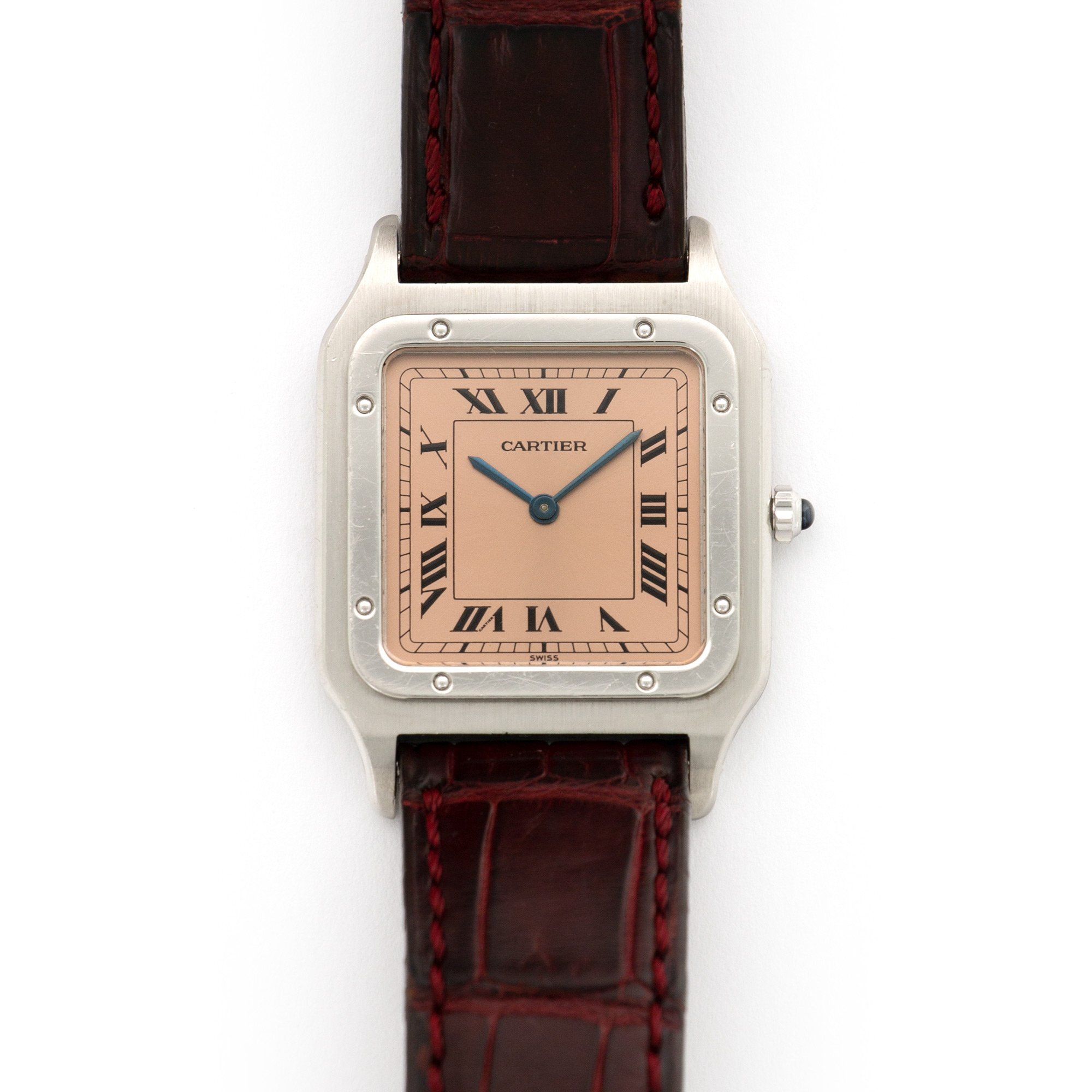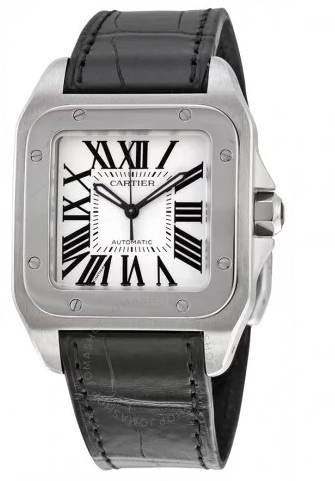Warning: This might be the longest article about the history of the Cartier Santos on the internet.
Cartier, the French jeweler and watchmaker, has perhaps the most enviable historical claim of any watch brand: purveyor of the first men’s wristwatch, the Cartier Santos, in 1911. Sure, Rolex and others have some notable technological innovations, but Cartier started it all.
Unfortunately for modern consumers, the Santos had not been updated in the Cartier catalog since 2004. That is, until 2018, when Cartier launched the Santos in 13 new models with two different sizes. In 2019, Cartier doubled down, launching a Santos Chronograph and a new entry-level quartz Santos, the Santos-Dumont.
Before looking at the most recent releases, let’s take a look at the history of the Cartier Santos.
1904: The Wristwatch Takes Flight
As the story goes, in 1904, Brazilian aviator Alberto Santos-Dumont complained to friend Louis Cartier about the unreliability and impracticality of using a pocket watch while flying. Cartier designed a flat wristwatch with a square bezel and gave it to Cartier, and the watch eventually caught on with other customers. Thus, the first mass-produced men’s wristwatch (and first pilot’s watch; take that IWC!) was born. While there’s debate about the first humans to take flight — Santos-Dumont or the Wright brothers — there is no debate about the first men’s wristwatch. What also can’t be debated is that Santos-Dumont became the first person to be filmed in an airplane flight in November 1906 when he took flight for 21.5 seconds, with a Cartier watch on his wrist.
Alberto Santos-Dumont
The Santos’ case was seemingly inspired by a square pocket watch Cartier had produced, but the highly legible dial design telegraphs a shift to Art Deco style that would define the 1920s and 1930s, and continues to define Cartier’s design aesthetic to this day.
The case was conceived to be robust and the screws that secured the glass were intended to recall the legs of the new Eiffel tower. Similarly, the blackened Roman numerals suggest the radial layout of Paris’ streets and wide boulevards.
By 1911, Cartier put the Santos-Dumont (note the name changes over the years. we’ll refer to “Santos” as the broader line over the years for simplicity, but nowadays Santos-Dumont refers to model styled after this original wristwatch) into full production, with a movement from Jaeger inside, making it the first men’s wristwatch.
When the Santos-Dumont watch hit shelves in 1911, it was offered in a variety of platinum and yellow gold models, all measuring a svelte, by today’s standards, 25mm x 35mm. The watches usually came with brown or black leather straps with a gold folding buckle. This is where we note another first: Cartier developed the deployant (folding buckle), and for years was the only such mechanism on the market. Props to Cartier, whose current-day QuickSwitch technology is another innovation in straps, which to too many brands are an afterthought.
A vintage Cartier Santos from the early 1900s.
Credit due to Patek Philippe, which had earlier invented the wristwatch for women, but Cartier’s design, along with the pioneering and universally admired Santos-Dumont wearing the watch around town, made it acceptable for men to wear wristwatches as well.
Cartier continued to manufacture the Santos through the first half of the 20th Century, though the advent of World War II — and the military requirements for round watches — meant the Santos’ square design saw a decline in popularity that persists to this day.
1970s: Santos as Sports Watch
The 1970s saw the introduction of new “luxury sport” watches (defined by high-end pieces made in stainless steel), highlighted by Gerald Genta’s Audemar Piguet Royal Oak and Patek Philippe Nautilus. In the wake of these successes, Cartier turned to the Santos to capitalize on the new trend.
In 1978, Cartier redesigned and renamed it the Santos de Cartier, giving the watch an integrated bracelet instead of the traditional leather strap. Cartier made the case and bracelet out of stainless steel, a true change in course for the maison that had only worked with precious metals before this time. Cartier also added 18k gold to the case and bracelet to give the watch a touch of luxury. This “bimetal” gold-steel design would go on to be extremely popular in the 1980s (think Wall Street’s Gordon Gecko), and, by the way, is making a bit of a comeback (our December 2018 Swiss watch exports report showing a rise in bimetal exports). Soon after releasing the bimetal Santos, Cartier also released an all-steel model.
The Santos Galbée and the Quartz Crisis
In 1987, the Santos was completely revised, renamed, and relaunched as the Santos Galbée. The case lost its boxy looks and became more curved around the lugs, fitting better on the wrist than the original Santos.
Most Santos Galbée models were quartz-powered, though some models featured mechanical movements. The Santos Galbée was last updated in 2005 with the release of the Santos Galbée XL. It was a larger watch, measuring 32 x 45 mm, reflecting the trend towards larger watches at the time. The XL was powered by an automatic ETA 049 calibre. It also featured a date window in the corner between 4 and 5 o’clock. It created a well-balanced dial that stayed true to the classic Santos look. The Santos Galbée also came in a bimetal steel and yellow gold case.
Santos-Dumont and the Collection Privée Cartier Paris
Image courtesy of The Keystone
While the sportier versions of the Santos tend to grab headlines during the 1970s and 1980s, Cartier was also reliably churning out the classically-styled Santos-Dumont in yellow gold. It came in both a “gentleman’s” and a “ladies’” size: 24mm for the men, 20mm for the women. Eventually, the men’s size was bumped up to 27mm across the dial, 36 mm from lug to lug — still quite small by the era’s standards. Typically, you’ll find the “ultra thin” version of the Santos-Dumont, which features the F. Piguet caliber 21, one of the thinnest manual-wind calibers of the time. But you’ll also find examples with ETA-powered movements, most commonly the ETA 2512. Typically, the Piguet 21-powered examples demand a premium.
In 1998, Cartier introduced the Collection Privée Cartier Paris, a line featuring many historical models outfitted with high-end manufacture calibers. Included among the releases were two new Santos-Dumont models. The case measures 36 x 27mm and came in platinum or yellow gold, powered by a Frédéric Piguet movement.
One of the most gorgeous Santos-Dumont models is the CPCP in platinum featuring a salmon dial. Just 90 examples were made to celebrate the Santos-Dumont’s 90th anniversary, and prices have been steadily rising over the past few years. Like other CPCP examples, it features a 36 x 27mm case, a manual-wind Piguet 21 caliber — but the dial is as striking as they come. Vintage and modern at the same time.
Along with the Santos 100 collection (more below), Cartier came out with a new Santos-Dumont in 2004, dubbed the “1913.” It featured Breguet-style hands and a case and movement similar to the 1998 version. It was a limited-edition of just 100 pieces in yellow gold and one in platinum; for this reason, it remains very desirable among collectors.
The Santos 100
Cartier Santos 100 Medium
Most recently, Cartier launched the Santos 100 collection. Launched in 2004 to commemorate the 100-year anniversary of Louis Cartier making a wristwatch for his buddy Santos-Dumont, the Santos 100 is a true modernization of the Santos. The base Cartier Santos 100 Large in steel with black strap, measures 51mm tall, 41mm wide (with crown) and 10.3mm thick. It’s a thoroughly modern case size that still doesn’t wear overly large because of the thinner case and short lugs. Meanwhile, the Santos 100 Medium is a square case measuring 35.6mm. Both came with automatic ETA calibres, the 049 (the same as the Santos Galbee XL) and 076, respectively.
Besides the base steel versions, the Santos 100 collection featured a range of experimentation with modern case materials. The Ref. W2020010 featured a stainless steel and black PVD stainless steel case with a black dial to match. The Santos Ref. W20072X7 also sports a steel case, but with an 18k yellow gold bezel screwed on top and comes on a brown alligator strap. The Ref. W2020010 (Large) and Ref. W2020008 (Medium) featured a black titanium case with a steel bezel.
The Santos 100 collection also featured a few chronographs, highlighted by the base stainless steel Ref. W20090X8. A titanium chronograph was also made, Ref. W2020005.
Cartier Santos 100 Chronograph in steel
Cartier also showed off its skills in fine watch making, introduced a transparent, skeletonized Cartier Santos 100 and its related models – the Santos-Dumont in White Gold (Ref. W2020033) and the Santos-Dumont in titanium with an ADLC coating (Ref. W2020052). Each skeletonized reference sports larger cases measuring 38mm wide and 51mm tall. The long Roman numerals, formed by the bridges of the watch’s movement, are reminiscent of the Art Deco era in which the timepiece was created. Most impressively, inside the watch is the first in-house manufactured movement by Cartier, the 128-part, manually wound 9611 MC.
These Santos 100 references, along with others, were variously manufactured from 2004 to 2017.
Cartier Santos 100 Skeleton
In recent years, Cartier has also made a Santos aimed towards women, the Santos Demoiselle. These models feature smaller case sizes, quartz movements, and come in steel, yellow gold, and white gold.
2018: The Santos Reborn
At SIHH 2018, Cartier finally updated the Santos after letting the collection lay dormant for more than decade. And Cartier didn’t debut just one watch, but a collection of 13 watches in two sizes, medium and large. Cartier was clearly trying to modernize its marketing efforts as well, using brand ambassador Jake Gyllenhaal in many of its promotional materials.
2018 Cartier Santos in pink gold
The 2018 Santos collection relies on many of the design queues from earlier Santos models, while staying true to its modern self. Notably, the lugs and case are more curved, invoking the shape of earlier Santos Galbée models. The large model measures 39.8mm x 47.5mm, while the medium version measures 35mm x 41.9 mm.
The new collection ranges in price from a large yellow gold skeletonized version at $52,000 (Ref. WHSA0010) or steel skeletonized for $26,800 (Ref. WHSA0007 ), down to the medium steel model which retails for $6,250. The steel skeleton uses the same manufacture calibre 9611 that the Santos 100 skeleton-style watches used, while the yellow gold model introduces the manufacture calibre 9619.
In both the medium and large case sizes, customers can choose from stainless steel, pink gold, and yellow gold cases. Beating inside both the medium and large versions of the Santos is the caliber 1847 MC, an in-house automatic movement measuring 25.6mm across and featuring 23 jewels and a 42-hour power reserve. There are date and no-date versions of the movement, which can accordingly be found in each case size. It’s a great movement from Cartier, and exciting to see them put an in-house movement inside the Santos after relying on ETA for years.
A Note on Innovation
Cartier didn’t just release a new Santos in 2018. It also showed off some of its new patent-pending technologies, which I was just as excited about at the time. The bracelet utilizes Cartier’s SmartLink system, which allows you to take bracelet links out yourself, without needing to visit a jeweler or boutique to make the adjustment. On the backside of the bracelet links, there’s a small button you can press that makes the pin holding the link in place pop out.
Cartier has made it equally easy to swap the Santos bracelet out for one of its beautiful leather straps, utilizing Cartier’s QuickSwitch system. All you have to do is push a tab between the lugs, which then lets you easily slide the bracelet or strap out.
I’ve owned watches for years and I’m still shit with a spring bar tool, so this is a genuinely cool innovation that I could see increasing my appreciation for the watch. Say what you want about the Apple Watch, but more brands could take a lesson from its quick strap-changing system.
To top it off, the Santos comes with both the bracelet and a leather strap, chosen by the purchaser at checkout, so rest assured you’ll get to use the tech inside the 2018 Santos.
2019: The Line Expands
As it turns out, Cartier was only getting started with the Santos in 2018. At SIHH 2019, it introduced a Santos Chronograph and a quartz Santos-Dumont, expanding the Santos line at both the high and low end.
The 2019 Santos Chronograph
The Santos Chronograph comes in “Extra Large”, measuring 43.3mm x 51.3mm, and sits 12mm thick. Again, there are a variety of metals to choose from: a stainless steel case with black steel bezel, a stainless steel case with 18k yellow gold bezel, or an all 18k rose gold. There are metal bracelets to match, as well as leather and rubber straps, all still featuring Cartier’s QuickSwitch system.
Cartier Santos Chronograph in steel and black ALDC steel
The Santos Chronograph also features an in-house 1904-CH MC automatic movement, but Cartier has made it so that the chronograph pusher sits on the left side of the case, opposite the crown. The reset button is integrated inside the crown, similar to that CPCP Monopusher we mentioned. It’s a pretty cool, if not functional, execution of a chronograph, and gives the case a symmetrical look (Nautilus vibes?). The Santos Chronograph — especially the steel and black steel versions — is a clear sports watch play, recalling the 1970s when Cartier began to position the Santos against more expensive offerings from AP and Patek.
The New Santos-Dumont
Along with the Santos Chronograph, Cartier launched the Santos-Dumont at SIHH 2019. It comes in two sizes, the small option measuring 27.5mm wide (38.5mm lug-to-lug), and the large version 31.4mm wide (43.5mm lug-to-lug).Cartier offers steel, two-tone, and rose gold models, and the watches only come on leather straps.
The dial design is similar to that of the first Santos (see photo of early 1900s vintage Santos above), with the long, thin Roman numerals. Additionally, the crown (that crown!) is a standout, a clear reference to the crown of early Santos models.
Now, the “bad”. It’s a quartz-powered movement, though Cartier says it offers six years of battery life. Cartier uses a similar strategy with the Tank, selling an entry-level quartz option to introduce enthusiasts to the line.
Cartier Santos Dumont in steel
The new Santos-Dumont starts at $3,650 for the 27.5mm in steel, the 31.4mm costs $3,900. The price tops out with the rose gold 31.4mm model is priced at $11,800. The lowest priced mechanical Santos is priced at $6,250, so the Santos-Dumont offers an interesting value proposition for those who appreciate Cartier’s design aesthetic (or just want a Cartier watch), but don’t want to ball out too much.
The Future of the Santos
With Cartier re-introducing the Santos in 2018 and expanding on the line in 2019, it seems committed to maintaining the watch as a foundational piece of its watch efforts. Sure, it might not have the universal appeal of the Tank (Jackie and Andy wore one!), but the Santos is just a cut deeper, giving it an appeal that enthusiasts may admire.
While the last iteration, the Santos 100, saw mixed reviews from critics and enthusiasts, the new Santos has been more well received, suggesting there is a continued modern appetite — if limited — for the Santos. Where the Santos 100 featured modern design queues and slapped an ETA movement inside the case, the 2018 iteration of the Santos reclaimed the line’s roots, featuring the classic lines of a Santos and an in-house caliber, reiterating Cartier’s commitment to being a legitimate watch maison in the 21st Century.
It’s a true testament to Cartier’s timeless design language that a watch first introduced to the world in 1904 still looks good some one hundred years later. I’m an advocate of buying classic fashion, furniture, whatever, and the Cartier Santos is perhaps the most perfect expression of that philosophy.










